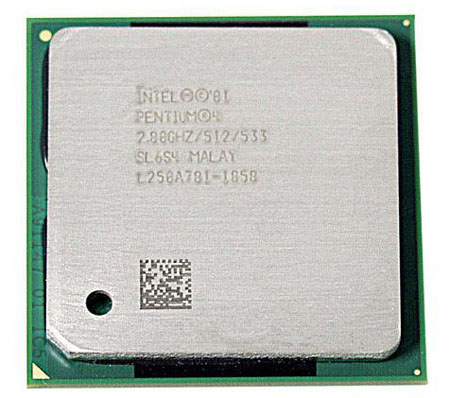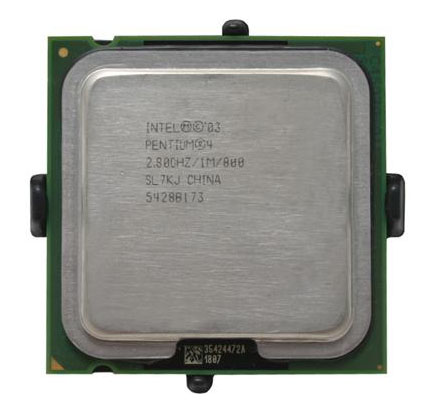Processor Obfuscation and You: An Update on AMD and Intel CPUs
by Kristopher Kubicki & Jarred Walton on May 17, 2005 12:00 PM EST- Posted in
- CPUs
Intel Processors
With AMD out of the way, we'll move on to the code names and features of all the currently shipping Intel processors. We only have two platforms this time - not counting the server and mobile options. The good news is that there isn't quite as much overlap in the Intel world. Sure, we have numerous chips running at similar clock speeds, but with a few exceptions, each model number explicitly defines one set of features. Where AMD has four different Athlon 64 3400+ chips (including the obscure 2.2 GHz 512K 939 chip that is limited to an 800 MHz HyperTransport link), the Intel Pentium 540J is always a 3.2 GHz Prescott core for socket 775. Let's take a look at the shipping cores.| Intel Processors | ||||
| Core Name | CPU Name | L2 Cache | Process | Notes |
| Socket 478 | ||||
| Northwood | Celeron | 128K | 130nm | No SSE3 |
| Northwood | Pentium 4 | 512K | 130nm | No SSE3 |
| Prescott | Celeron D | 256K | 90nm | |
| Prescott | Pentium 4 | 1024K | 90nm | |
| Socket (LGA) 775 | ||||
| Prescott | Celeron D | 256K | 90nm | Partial EM64T |
| Prescott | Pentium 4 5xx | 1024K | 90nm | Partial EM64T |
| Irwindale | Pentium 4 6xx | 2048K | 90nm | |
| Cedar Mill | Pentium? | 2048K | 65nm | |
| Smithfield | Pentium D | 2 x 1024K | 90nm | Dual Core |
| Presler | Pentium D? | 2 x 2048K | 65nm | Dual Core |
Socket 478

For 2.8 GHz and above, we'd say look to overclocking first (if you haven't already), and if you're still unsatisfied, you'll probably want to ditch the platform rather than investing more money. Those running anything less than a 2.6 GHz chip might consider purchasing one of the faster chips before they entirely disappear, but you're basically delaying the inevitable. Unlike AMD, however, socket 775 doesn't offer a whole lot in the way of improved performance. DDR2 and PCI Express won't be available without switching to socket 775, but they're not truly necessary. We wouldn't spend a whole lot of money on a new AGP card, but if you already have something reasonably powerful, you're probably best off waiting a bit longer to upgrade from anything sporting an 865PE or 875P chipset (or else jumping ship and purchasing an AMD system).
Socket 775

The next Intel core is Smithfield, which received its official name with the recently released Pentium D processors - although really, we should call them "the recently announced" Pentium D processors, as they are not yet available for purchase at any retailers. (That should hopefully change in the next month.) Smithfield processors will use 8xx model numbers to differentiate them from their single core relatives. Like the 6xx series, the 8xx processors all feature support for EIST and EM64T, but they add a second core. Multitasking in particular stands to benefit a lot from the addition of a second core, but for running a single-threaded application (without a bunch of other processes), a higher clocked 5xx or 6xx chip is still going to be faster. The Extreme Edition also has HyperThreading enabled, allowing the execution of four simultaneous threads. Unfortunately, HyperThreading is not always beneficial, as there are cases where the Pentium Extreme Edition 840 is outperformed by the Pentium D 840.
There are drawbacks for Pentium D: heat output and power consumption. The power draw of a Pentium D system scales rapidly with increased clock speeds. In order to combat this, Intel has been forced to reduce the shipping clock speeds of their dual core chips. This means that while 3.6 and 3.8 GHz parts are available for the 5xx and 6xx lines, the fastest 8xx chip is currently 3.2 GHz. Sure, the relative power draw of Pentium D may only be 15% higher than Pentium 4, but when you're talking about 100+ Watts, removing an additional 15% can become difficult. You could also say that the lower clock speeds tie into the more affordable prices that Intel is presenting. Where AMD is essentially releasing dual core variants of their 3500+ and higher processors, Intel is only releasing 2.8 to 3.2 GHz parts. If AMD had 1.8 and 2.0 GHz dual core parts, the prices might be quite a bit lower.
Even with these drawbacks, the Pentium D is still an attractive part for many people. The biggest problem is that the Pentium D is not yet available for purchase, and while it uses the same socket (LGA 775), you need a motherboard with one of the new 945/955 Intel chipsets. (The NVIDIA nForce 4 SLI chipset will also work, provided that the motherboard manufacturer has designed their board properly.) If you're serious about purchasing a new computer and you're set on an Intel system, we would strongly recommend waiting for the new motherboards and processors to become available.










55 Comments
View All Comments
Tarumam - Tuesday, May 17, 2005 - link
BTW, thanks Kris & Jarred. This is just the kind of article that helps us readers to make the right decision. Much better read then those EE P4 or FX 59 dual core non sen$e...Tarumam - Tuesday, May 17, 2005 - link
I mean I don´t care about upgrade unless I realy need my system to do something faster or need it to do something the older can´t do at all. Who cares if I don´t have the fastest machine on the planet? All I want is a capable PC and I want to wear it out before the next leap.And save some cash doing that is just great!
Tarumam - Tuesday, May 17, 2005 - link
Well, what can I say? I use to love my socket A (XP 1700+ Via KT266A and Radeon 8500) as it was a screaming beast 4 years ago. when I bought it everyone was talking about how good and expensive P4 was. Now I just love my 754 3400+ in a small desktop (mAtx) as it does everything I need it to do very fast. The latest and gratest are there so I can build myself an incredible system (64 bit capable, lots of mem, SATA HD and a very decent 6600GT) for a reasonable bargain! Just love when some geek panics in distress: "OMFG my 939 single core is now obsolete! I gotta upgrade again...".JBird7986 - Tuesday, May 17, 2005 - link
My only issue with this article occurs with the statement that the "obscure" Socket 939 A64 3400+ is limited to an 800MHz HyperTransport link. Seeing as how I own one, and it is running at the full 1000MHz HyperTransport link, this seems to be a misstatement.Amplifier - Tuesday, May 17, 2005 - link
First